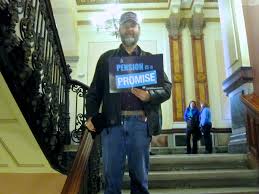
By Robert Lyons, retired teacher and former annuitant representative on the board of the Illinois Teacher Retirement System (TRS).
When is a solution not a solution? When it does not solve the problem. In 1994 the five state pensions plans (TRS, SERS, SURS, JRS, GARS) had a total unfunded liability of $15 billion. That was a problem and the state of Illinois acted. Led by Governor Edgar the General Assembly voted unanimously to follow a plan that had as its goal to achieve a 90 percent funding for the five state retirement systems by fiscal year 2045. By the time the plan went into effect in 1995 the unfunded liability had grown to $20 billion. A year ago at the end of fiscal year 2017 after twenty-two years of the plan the unfunded liability was $130 billion.
Wait, that cannot be right? But it is.
In 1995, newly retired, I was glad that there was finally a plan to deal with the unfunded liability in the Illinois pensions, but I did not question the details. Well, just last week I heard a state representative, one who taken tough votes in support of retired teachers, say that we should be pleased that the General Assembly had followed the plan in voting to fund the pensions for FY 2019. I think for that reason alone we need to look at what following the plan has meant for the state pension systems.
First, there was a fifteen-year ramp to gradually increase the state’s contributions, which was designed to make it easier to sell the fifty-year plan to the legislators by allowing them to vote to “solve” the problem of funding the pensions while still enabling them to continue to vote for popular projects. Second the plan could be amended when needed to allow the legislators to depart from the plan when they did not have the money, which they did in fiscal years 2006 and 2007, “saving” $2.3 billion which was subtracted from the pensions payments with the approval of the IEA, the IFT, and SEIU to spend the money on more popular causes and gaining the approval of a four extension of the ERO. It is certainly possible that the union leaders did not realize that shorting the pension funds by a little more than $2 billion would in the long run cost over $6 billion in growing the unfunded liability. By the time the ramp had come to an end in 2010 the unfunded liability had grown to almost $76 billion.
With the end of the so-called ramp the legislature realized that with the significant growth of the unfunded liability that they needed to be committed to ever-growing payments.
The real failure of the fifty-year plan was that it allowed for the unfunded liability to continue growing and also that it was heavily back-loaded. The original funding scheme did not call for the pension payments to grow large enough to begin to really reduce the growth of the unfunded liability until 2034 and it called for the total funding in the last five years of the plan to total $75 billion.
While it could be argued that any plan was better than no plan, but they could have made a better plan. It is equivalent to paying down your credit card. Smaller payments in the beginning mean larger payments in the long run.Any actuary would have told them that the best plan would have called for dividing the amount owed into even payments with a goal of eventually reaching a hundred percent funded. But required larger payments was not what they wanted to pay. The sooner a pension fund reaches full funding the better. Pension funds invest every dollar they can with the hope that their investments will grow and reduce the need for external funding. Illinois pension funds, on the other hand, are currently required to take money out of profitable investments in order to pay annuitants their pensions. “They had to eat their seed corn or starve.”
The last five years has seen the funding grow for the five state pensions funds while at the same time the funded ratio has barely moved. In 2013 the five funds were 39.3% funded, 2014: 39.3%, 2015: 40.9%, 2016: 39.2% and 2017: 39.9%. In the last five year each of the pension systems made money, their investments grew, but the unfunded liability climbed as well as the state’s payments were less than what was needed and, as already stated, it was $130 billion at the end of FY2017.
The new budget for FY2019 calls for the state to contribute to the TRS pension fund $4.466 billion, a 9.05% increase over this year’s contribution of $4.095 billion. More than 70% of the payment to TRS is to partially pay what they owe because of the underfunding. You can expect to hear state legislators say with some pride that this payment meets the requirement of the fifty- year plan, but it must be noted that the payment, as large as it is, still falls far short of moving TRS toward full funding by $2.9 billion.
In 2017 TRS reported that its “investment returned 12.6% net of fees and the Systems 30 year-return was 8.1%. Total investment income was $5.5 billion.” We will not learn how TRS has done for FY2018, which ends June 30 until likely late August when the last numbers for real estate and private equity funds are finally reported. We do know that the $49.468 billion that we had at the end of June last year had grown to $51.541 billion at the end of March of this year. While still dependent on how their investments do in the last couple of weeks of the fiscal year, it certainly looks this will be another positive year for TRS, but it will still likely end the year only about 41% funded.
The Teachers’ Retirement System ended 2017 at 40.2% funded, the University Retirement System was at 44.4% funded, the State Employees’ Retirement System was 35.5%, the Judges Retirement System was 35.6%, and the General Assembly Retirement System was 14.9%. Yes, the retirement system for the legislators, which has over 400 annuitants, is just only a market crash away from insolvency, and many of the most recently elected senators and representatives have opted out of the system.
That General Revenue portion of the Illinois state budget for FY2019 calls for spending $38.5 billion, and of that, the total for the five pensions system is $8.5 billion. In addition the state will pay $1.6 billion in debt service for Governor Quinn borrowing to pay pensions some seven years ago. In almost every state in the nation three to four percent of their budget for pensions is considered normal. In Illinois we are paying 22%, or 26% if we add the cost of borrowing. And recall that is still not an adequate payment to stop, let alone reverse, our underfunding from growing.
That is the dilemma that the state of Illinois and we the citizens of the state are paying for following a plan that was not in reality a solution for the problem that they were trying to solve. Not only has the problem grown, it will continue to grow.
It is late, but the only real solution is a variation of the one suggested by Ralph Martire of the Center for Tax and Budget Accountability. He calls for reamortizing the debt with equal payments with a goal to reach 80% funding and selling bonds to make the payments. Paying the bonds simply shifts the responsibility to the next generation. I would prefer passing a referendum for a progressive income tax and using the increased tax revenue to try to pay down the unfunded liability directly through equal annual payments. Considering the role the new progressive state income would play in solving what the state owes the pensions, I think we should accept paying state taxes on larger pensions. I do not think it is fair to ask others to pay more unless we are willing to help contribute ourselves to a solution that works.








